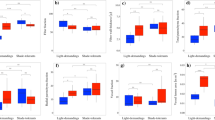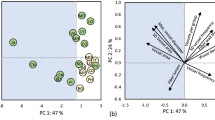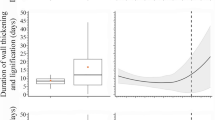Abstract
Key message
Positive radial trends in WSG were common among light-demanding species, and were mainly explained by radial shift in fiber and parenchyma traits.
Abstract
Trees can modify their wood structure in response to changes in mechanical, hydraulic and storage demands during their life-cycles. Thus, examining radial variations in wood traits is important to expand our knowledge of tree functioning and species ecological strategies. Yet, several aspects of radial changes in wood functional traits are still poorly understood, especially in angiosperm trees from tropical humid forests. Here, we examined radial shifts in wood traits in trunks of tropical forest species and explored their potential ecological implications. We first examined radial variations in wood specific gravity (WSG). Then, we asked what anatomical traits drove radial variations in WSG, and whether WSG, vessel fraction and specific hydraulic conductivity vary independently from each other along the radius gradients. We measured WSG and eight wood anatomical traits, at different radial positions along the trunks, in 19 tree species with contrasting shade-tolerance from a lowland tropical forest in eastern Amazonia. Most species had significant radials shifts in WSG. Positive radial gradients in WSG (i.e., increments from pith to bark) were common among shade-intolerant species and were explained by different combinations of fiber and parenchyma traits, while negative radial shifts in WSG (e.g., decreases towards the bark) were present in shade-tolerants, but were generally weakly related to anatomical traits. We also found that, in general, WSG was unrelated to vessel fraction and specific hydraulic conductivity in any radial position. This study illustrates the contrasting radial variations in wood functional traits that occur in tree species from a humid lowland tropical forest. In particular, our results provide valuable insights into the anatomical traits driving WSG variations during tree development. These insights are important to expand our knowledge on tree ecological strategies by providing evidence on how wood allocation varies as trees grow, which in turn can be useful in studying trait-demography associations, and in estimating tree above-ground biomass.


Similar content being viewed by others
Availability of data
The datasets analyzed during the current study are available in the OSF repository, [ https://doi.org/10.17605/OSF.IO/HS3MA].
Code availability
No.
References
Amusant N, Nigg M, Thibaut B, Beauchene J (2014) Diversity of decay resistance strategies of durable tropical woods species: Bocoa prouacencis Aublet, Voucapoua americana Aublet, Inga alba (Sw.) Wild. Int Biodeterior Biodegrad 94:103–108
Anten NPR, Schieving F (2010) The role of wood mass density and mechanical constraints in the economy of tree architecture. Am Nat 175:250–260
Baas P, Beeckman H, Čufar K, De Micco V (2016) Functional traits in wood anatomy. IAWA J 37:124–126
Baraloto C, Hardy OJ, Paine T et al (2012) Using functional traits and phylogenetic trees to examine the assembly of tropical tree communities. J Ecol 100:690–701
Beeckman H (2016) Wood anatomy and trait-based ecology. IAWA J 37:127–151
Bossu J (2015) Potentiel de "Bagassa guianensis" et "Cordia alliodora" pour la plantation en zone tropicale. Description d'une stratégie de croissance optimale alliant vitesse de croissance et qualité du bois. PhD Thesis, University of Guyane, French Guiana
Bossu J, Lehneback R, Corn S, Regazzi A, Beauchêne J, Clair B (2018) Interlocked grain and density patterns in Bagassa guianensis: changes with ontogeny and mechanical consequences for trees. Trees 32:1643–1655
Burnham KP, Anderson DR (2002) Model selection and multimodel inference: a practical information- theoretic approach. Springer, New York
Carlquist S (2001) Comparative wood anatomy: systematic, ecological and evolutionary aspects of dicotyledon wood. Springer, Berlin
Carneiro de Oliveira J, Mendes dos Santos MG, Santos SP, Vitória AP, Rossato DR, Pedreira de Miranda L, Funch LS (2021) Leaf trait variability maintains similar leaf Exchange rhythms in Hirtella glandulosa Spreng. (Chrysobalanaceae) populations growing on contrasting soil types in the Brazilian Atlantic Forest. Brazil J Botany 44:753–765
Chave J, Coomes D, Jansen S, Lewis SL, Swenson NG, Zane A (2009) Towards a worldwide wood economics spectrum. Ecol Lett 12:351–366
De Mil T, Tarelkin Y, Hahn S et al (2018) Wood density profiles and their corresponding tissue fractions in tropical angiosperm trees. Forests 9:763–777
Favrichon V (1994) Classification des espèces arborées en groupes fonctionnels en vue de la realisation d’un modèle de dynamique de peuplement en forêt guyanaise. Revue D’ecologie Terre Et Vie 49:379–403
Ferry B, Morneau F, Bontemps JD, Blanc L, Freycon V (2010) Higher treefall rates on slopes and waterlogged soils result in lower-stand biomass and productivity in a tropical rain forest. J Ecol 98:106–116
Fortunel C, Ruelle J, Beauchene J, Fine PVA, Baraloto C (2013) Wood specific gravity and anatomy of branches and roots in 113 Amazonian rainforest tree species across environmental gradients. New Phytol 202:79–94
Fujiwara S (1992) Anatomy and properties of Japanese hardwoods II. Variation of dimensions of ray cells and their relation to basic density. IAWA Bull Ns 13:397–402
Gärtner H, Lucchinetti S, Schweingruber FH (2015) A new sledge microtome to combine wood anatomy and tree-ring ecology. IAWA J 36:452–459
Gourlet-Fleury S, Guehl JM, Laroussine O (2004) Ecology and management of a neotropical rainforest: lessons drawn from Paracou, a long-term experimental research site in French Guiana. Elsevier, Paris
Hérault B, Bachelot B, Poorter L et al (2011) Functional traits shape ontogenetic growth trajectories of rain forest tree species. J Ecol 99:1431–1440
Hietz P, Valencia R, Wright SJ (2013) Strong radial variation in Wood density follows a uniform pattern in two neotropical rain forests. Funct Ecol 27:684–692
Hietz P, Ronser R, Hietz-Seifert U, Wrigh SJ (2016) Wood traits related to size and life history of trees in a Panamanian rainforest. New Phytol 213:170–180
Hillis WE (1987) Heartwood and tree exudates. Springer, Berlin
Jacobsen AL, Agenbag L, Esler KJ, Pratt RB, Ewers FW, Davis SD (2007) Xylem density, biomechanics and anatomical traits correlate with water stress in 17 evergreen shrub species of the Mediterranean-type climate region on South Africa. J Ecol 95:171–183
King DA, Davies SJ, Tan S, Noor NS (2006) The role of wood density and stem support costs in the growth and mortality of tropical trees. J Ecol 94:670–680
Kollman F, Coté WA (1968) Principles of wood science technology. I. Solid wood. Springer-Verlag, New York
Lachenbruch B, Moore JR, Evans R (2011) Radial variation in wood structure and function in woody plants, and hypotheses for its occurrence. In: Meinzer FCC, Lachenbruch B, Dawson TEE (eds) Size- and age-related changes in tree structure and function. Springer, Dordrecht, pp 121–164
Larjavaara M, Muller-Landau H (2010) Rethinking the value of high wood density. Funct Ecol 24:701–705
Lehnbach R, Bossu J, Va S, Morel H, Amusant N, Nicolini E, Beauchêne J (2019) Wood density variations of legume trees in French Guiana along the shade tolerance continuum: heartwood effects on radial patterns and gradients. Forests 10:1–22
Levionnois S, Ziegler C, Jansen S, Calvet E, Coste S, Stahl C, Salmon C, Delzon S, Guichard C, Heuret P (2020) Vulnerability and hydraulic segmentations at the stem– leaf transition: coordination across Neotropical trees. New Phytol 228:512–524. https://doi.org/10.1111/nph.16723
Li L, McCormack ML, Ma C et al (2015) Leaf economics and hydraulic traits are decoupled in five species- rich tropical-subtropical forests. Ecol Lett 18:899–906
Loubry D (1994) La phénologie des arbres caducifoliés en forêt guyanaise (5° de latitude nord): illustration d’un déterminisme à composantes endogène et exogène. Can J Bot 72:1843–1857
Marks CO, Lechowicz MJ (2006) Alternative designs and the evolution of functional diversity. Am Nat 167:55–66
Martínez-Cabrera H, Jones CA, Espino S, Schenk HJ (2009) Wood anatomy and density in shrubs: Responses to varying aridity along transcontinental transects. Am J Bot 96:1388–1398
McDonald S, Williamson B, Wiemann MC (1995) Wood specific gravity and anatomy in Heliocarpus appendiculatus (Tiliaceae). Am J Bot 82:855–861
Molino JF, Sabatier D (2001) Tree diversity in Tropical Rain Forests: A validation of the Intermediate Disturbance hypothesis. Science 284:1702
Morris H et al (2016) A global analysis of parenchyma tissue fractions in secondary xylem of seed plants. New Phytol 209:1553–1565
Nock C, Geihofer D, Grabner M, Baker PJ, Bunyavejchewin S, Hietz P (2009) Wood density and its radial variation in six canopy tree species differing in shade-tolerance in western Tailand. Ann Bot 104:297–306
Olson M, Rosell J (2013) Vessel diameter-stem diameter scaling across woody angiosperm and the ecological causes of xylem vessel diameter variation. New Phytol 197:1204–1213
Osazuwa-Peters O, Wright JS, Zanne AE (2014) Radial variation in wood specific gravity of tropical tree species differing in growth-mortality strategies. Am J Bot 101:803–811
Plourde BT, Boukill VK, Chazon RL (2015) Radial changes in wood specific gravity of tropical trees: inter- and intraspecific variation during secondary succession. Funct Ecol 29:111–120
Poorter L, McDonald I, Alarcon A et al (2010) The importance of Wood traits and hydraulic conductance for the performance and life history strategies of 42 rainforest tree species. New Phytol 185:481–492
Popma J, Bongers F, Werger MJ (1992) Gap-dependence and leaf characteristics of trees in a tropical lowland rain forest in Mexico. Oikos 63:207–214
R Core Development Team (2019) R: a language and environment for statistical computing. R Core Development Team, Vienna, Austria
Rodrigues AMS. (2010) Análise e valorizaçao bioinspirada dos metabólitos secundários responsáveis pela durabilidade natural de madeiras exploradas na Guiana Franesa. PhD Thesis, University of Brasilia, Brazil.
Rodríguez-Calcerrada J, Salomon RL, Gordaliza GG et al (2019) Respiratory costs of producing and maintenance stem biomass in eight co-occurring tree species. Tree Physiol 39:1838–1854
Rozendaal DM, Hurtado VH, Poorter L (2006) Plasticity in leaf traits of 38 tropical tree species in response to light; relationships with light demand and adult stature. Funct Ecol 20:207–216
Rungwattana K, Hietz P (2017) Radial variation of wood functional traits reflects size- related adaptations of tree mechanics and hydraulics. Funct Ecol 32:260–272
Santiago L, Goldstein G, Meinzer FC et al (2004) Leaf photosynthetic traits with hydraulic conductivity and wood density in Panamanian forest canopy traits. Oecologia 140(543):550
Santiago L, De Guzman M, Baraloto C et al (2018) Coordination and trade-offs among hydraulic safety, efficiency and drought avoidance traits in Amazonian rainforest canopy tree species. New Phytol 218:1015–1024
Schüler E, Martínez-Ramos M, Hietz P (2016) Radial gradients in wood specific gravity, water gas content in trees of a Mexican tropical rain forest. Biotropica 45:280–287
Shipley B, De Bello F, Cornelissen JHC, Laliberté E, Laughlin D, Reich P (2016) Reinforcing loose foundation stones in trait-based plant ecology. Oecologia 180:923–931
Ter Steege H, Sabatier D, Castellanos H et al (2000) An analysis of the floristic composition and diversity of Amazonian forests including those of the Guiana Shield. J Trop Ecol 16:801–828
Ter Steege H, Pitman NCA, Phillips OL et al (2006) Continental-scale patterns of canopy tree composition and function across Amazonia. Nature 443:444–447
Tyree MT, Zimmermann MH (2002) Xylem structure and the ascent of sap. Springer, Berlin
Valladares F, Wright JS, Lasso E, Kitajima K, Pearcy RW (2000) Plastic phenotypic responses to light of 16 congeneric shrubs from a Panamanian rainforest. Ecology 81:1925–1936
Van der Werff H (1997) Sextonia, a new genus of Lauraceae from South America. Novon 7(4):436–439
Vega L (1977) La silvicultura de Cordia alliodora (Ruiz and Pav.) Oken. como especie exótica en Surinam. Bol Inst for Latino-Am Investig Capacit 52:3–26
Venables WN, Ripley BD (2002) Modern applied statistics with S, 4th edn. Springer, New York
Vincent G, Molino JF, Marescot L et al (2011) The relative importance of dispersal limitation and habitat preference in shaping spatial distribution of saplings in a tropical moist forest: case study along a combination of hydromorphic and canopy disturbance gradients. Ann for Sci 68:357–370
Wagner F, Hérault B, Stahl C, Bonal D, Rossi V (2011) Modeling water availability for trees in tropical forests. Agric for Meteorol 151:1202–1213
Westoby M, Wright I (2006) Land-plant ecology on the basis of functional traits. Trends Ecol Evol 21:261–267
Wiemann MC, Williamson GB (1989) Wood specific gravity gradients in tropical dry and montane rain forest trees. Am J Bot 76(6):924–928
Williamson GB, Wiemann MC (2010a) Age-dependent radial increases in wood specific gravity of tropical pioneers in Costa Rica. Biotropica 42:590–597
Woodcock DW, Shier AD (2002) Wood specific gravity and its radial variation: the many ways to make a tree. Trees 16:437–443
Zanne A, Westoby M, Falster DS et al (2010) Angiosperm wood structure: global patterns in vessel anatomy and their relation to Wood density and potential conductivity. Am J Bot 97:207–215
Zieminska K, Butler DW, Gleason SM, Wright IJ, Westoby M (2013) Fibre wall and lumen fractions drive wood density variation across 24 Australian angiosperms. AoB Plants 5:1–13
Zieminska K, Westoby M, Wright IJ (2015) Broad anatomical variation within a narrow wood density range—a study of twig Wood across 69 Australian Angiosperms. PLoS ONE 10:1–25
Zobel BJ, van Buijtenen JP (1989) Wood variation, its causes and control. Springer, Berlin
Acknowledgements
We are very grateful to Jonathan Prunier for laboratory and field support, and to Pascal Petronelli for his help with botanical identification. We kindly thank Soepe Koese for his help collecting and preparing the wood samples. We would also like to thank Camila Monje and Laura Baldion who assisted in processing anatomical images, and to Julie Bossu for providing some wood samples. The study was designed by A.G.M., J.M.P., B.C. and J.B. Most wood samples were collected by R.L. and A.G.M. Additional samples were provided by B.C., J.B. and S.L. Anatomical images were processed by A.G.M. and K.R. Data analyses were performed by A.G.M. with contributions from J.M.P. The first draft of the manuscript was written by A.G.M. with inputs from J.M.P. All authors contributed equally to the writing and interpretation of advanced versions of the manuscript.
Funding
This study was funded by a student grant awarded to A.G.M by COLCIENCIAS (Colombian Agency for Science and Technology. Grant 476), and a field grant from the University of Guyane in the framework of the Erasmus + Program. We know of no conflicts of interest associated to this manuscript.
Author information
Authors and Affiliations
Corresponding author
Ethics declarations
Conflict of interest
The authors have no conflicts of interest to declare.
Ethics approval
Not required.
Consent to participate
Not required.
Consent for publication
Not required.
Additional information
Communicated by S. Vospernik.
Publisher's Note
Springer Nature remains neutral with regard to jurisdictional claims in published maps and institutional affiliations.
Supplementary Information
Below is the link to the electronic supplementary material.
Rights and permissions
About this article
Cite this article
González-Melo, A., Posada, J.M., Beauchêne, J. et al. Radial variations in wood functional traits in a rain forest from eastern Amazonia. Trees 36, 569–581 (2022). https://doi.org/10.1007/s00468-021-02229-1
Received:
Accepted:
Published:
Issue Date:
DOI: https://doi.org/10.1007/s00468-021-02229-1




